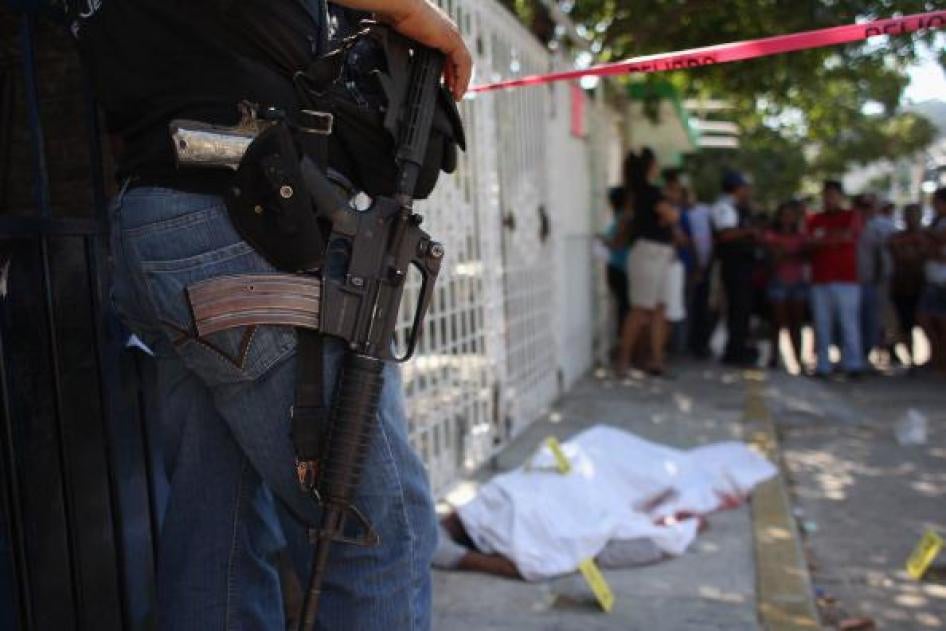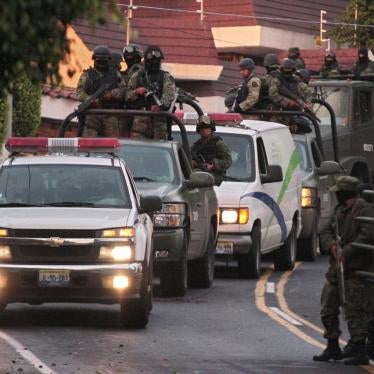This article is the second in the series "Lessons from a Human Rights Catastrophe." The complete series is available here.
The most remarkable—and remarked upon—fact about Mexico’s “drug war” is the staggering number of homicides in the country. Indeed, according to official figures, more than 240,000 people have been killed since this “war” began in 2006.
Less frequently remarked upon—but also staggering—is how little is known about these killings. More than a decade after President Felipe Calderón began this ill-fated “war,” basic questions remain unresolved for the vast majority of the cases: Who committed them? Under what circumstances? Why?
Through the first five years of his presidency, Calderón offered a simple answer: 90 percent of the killings related to the “drug war” were criminals killing each other. He repeated this claim as the number of organized crime-related homicides grew to a cumulative 34,000 by 2011. A Human Rights Watch delegation met with him that year in Los Pinos to present a report about systematic abuses committed by police and armed forces during his presidency. Among our findings: he had no credible basis for his 90 percent claim.
During his presidency, the federal prosecutor’s office had opened investigations into fewer than 1,000 of the killings, filed charges against 343 suspects, and obtained convictions against only 22. State prosecutors may have also prosecuted a fraction of the 34,000 cases. But the vast majority had not been resolved. They had not even been investigated.
In lieu of proper judicial investigations, the Calderón administration had released, in January 2011, a “database” of the 34,000 homicides it attributed to violence involving organized crime. It was a database with minimal data. It indicated the month and the municipality in which killings had occurred, but nothing else. Nothing about the killers, the victims, the circumstances, the motives. And nothing to substantiate the conclusion that 90 percent were cases of killings between criminal groups.
This isn’t to suggest there weren’t many killings between criminal groups. Undoubtedly there were—along with cases of victims who weren’t involved with organized crime and, of course, police and soldiers who lost their lives in the line of duty.
What was missing was reliable information regarding the nature and circumstances of the killings—needed both to bring perpetrators to justice and to assess the effectiveness of public security policies.
President Peña Nieto had an opportunity to set a new course for Mexico and ensure proper investigations of the killings, publicize the results, and promote justice. Instead, his administration chose to shift attention elsewhere—as if by not talking about the bloodshed, it would go away. That, obviously, did not happen. The number of homicides decreased from 2012 to 2014, but then climbed by more than 60 percent over the next three years, reaching above 25,000 in 2017, the highest number in two decades.
Security forces continued to commit atrocities. And the authorities continued to make negligible progress in resolving these cases. The federal prosecutors’ office only opened 217 homicide investigations between December 2012 and January 2018, much less than during the previous administration. And it obtained convictions in only 4 cases.
President-elect Andrés Manuel López Obrador has pledged to promote public debate regarding the future of the country’s “drug war.” New policies are clearly needed to rein in the violence. But for a public debate to be productive, it will require a well-informed public. And that will require the new government to do far more than its predecessors to generate and share information regarding the violence the “drug war” has unleashed.
A Vast Cover-Up
The lack of reliable information regarding the violence in Mexico is no accident. It is, rather, the product of an array of practices by multiple government institutions that have the cumulative effect of a vast cover-up.
The cover-up sometimes begins in the immediate aftermath of a killing, when security forces disregard their legal obligation to preserve the crime scene—or, worse, intentionally alter evidence that they themselves may have broken the law. In a majority of the extrajudicial execution cases documented in our 2011 report, soldiers or police manipulated, concealed, or destroyed evidence to make it look like their victims had been armed aggressors or were the casualties of shootouts between rival cartels.
These dissimulations don’t require much effort, as the odds of a rigorous investigation by authorities are extremely low. In many cases, investigations are opened but go nowhere, as investigators fail to take such basic steps as conducting ballistics tests and interviewing witnesses. Or worse still, investigators “resolve” cases with confessions and testimonies that are obtained through torture and are therefore unreliable and invalid.
This failure to conduct proper investigations is encouraged by two fundamental biases that are common among justice officials. One is a bias against the victims of violence. As the mother of one victim told us: “[T]he official stance is: if something happened to you, it’s because you were involved in something bad.” It’s essentially the same stance that President Calderón took when claiming that 90 percent of the deaths were cases of killings between criminal groups. Not only was the claim unsubstantiated, it was insidious. Why seek the truth when the essential facts are already known? Why seek justice when the victims were, themselves, criminals?
The second bias is one in favor of government authorities. Officials accept as fact whatever they are told by other officials. For weeks after the Tlatlaya massacre, for example, the government maintained that the killing of 22 people by soldiers was the result of a gun battle with a criminal gang, despite compelling evidence that there had been extrajudicial executions. Prosecutors waited more than two months to open an investigation, after independent journalists reported that survivors said they had witnessed executions and had been tortured to exonerate the military.
During a meeting with Attorney General Jesús Murillo Karam at the time, I asked whether prosecutors were also investigating the possible role of military and civilian officials in covering up the crime. "What cover-up?" he responded indignantly. The officials had merely reported what the commander had reported, he said. The prosecutors, he claimed, had to presume "good faith" on the part of other state institutions.
This presumption of “good faith” is not uncommon among government officials the world over. What makes it especially problematic in Mexico is how it’s applied—even to institutions with track records of abuse and cover-up—with a fervor typically associated with authoritarian states, in which the primary function of the justice system isn’t to procure justice but to reinforce and protect the authority of the regime.
The truth about the violence
There have been some efforts during the Peña Nieto presidency toward uncovering the actual truth regarding the violence. But it’s come primarily thanks to civil society, not the government. Human rights advocates, journalists, scholars, and independent investigators have managed—in the face of often daunting obstacles—to obtain, analyze and disseminate information that the authorities sought to cover up or simply failed to provide.
Civil society has repeatedly debunked the official accounts of killings by security forces in Tlatlaya and other well-known cases. In addition to exposing atrocities, they found evidence that perpetrators acted under orders from their superiors. In 2016, the journalist collective Cadena de Mando published interviews with soldiers facing criminal proceedings who said it was standard practice for their commanding officers to instruct them to execute detainees. “[T]he commander tells you ‘don’t worry, kill them, don’t leave anything alive,’” one soldier said. “That was rule number one, the dead don’t speak, the dead don’t testify.”
Other independent investigators have found evidence that the extrajudicial executions by security forces may have been systematic. In 2014, researchers affiliated with the Centro de Investigación y Docencia Económicas (CIDE) and the National Autonomous University of Mexico (UNAM) obtained official data regarding confrontations between federal security forces and presumed members of organized crime. They found that, between 2007 to 2014, for every “alleged aggressor” that soldiers injured, on average, they killed another eight. One would expect to find such numbers if orders to execute injured and detained people—such as those described by the soldiers that Cadena de Mando interviewed—were commonplace.
In the early weeks of the Peña Nieto presidency, CIDE obtained a treasure trove of official data from an anonymous source on more than 40,000 homicides that occurred between 2007 and 2011. The investigators spent several years sorting through the data and produced a series of studies that painted a devasting picture of Mexico’s “war on drugs.” One study examined the impact of armed confrontations between security forces and civilians at the municipal level and found that, on average, each confrontation caused an increase in the local homicide rates.
Another looked at the circumstances in which security forces engaged in armed confrontations with civilians and found that in most cases (84%), the encounters were precipitated by the actions of the security forces themselves, not the “alleged aggressors” they shot. In only a tiny fraction (2%) of these encounters had the security forces been acting upon an arrest warrant or other judicial order. In other words, the security forces weren’t acting as mere auxiliaries of the criminal justice system. They were engaging in armed combat. And they were the ones taking the battle to their enemy.
When these studies appeared, a few critics questioned whether the data presented were sufficient to support the authors’ conclusions. Yet the studies themselves emphasized the limitations of the available data, and the authors were careful to point out that some of their findings regarding the legality of the use of force were tentative. In fact, one of their main conclusions was that much more information was needed to be able to assess the performance of the country’s security forces.
Instead of providing more information, the Peña Nieto administration opted for greater opacity. Instead of examining and explaining the tally of homicides related to organized crime, it simply chose not to tally them at all. Instead of investigating the suspiciously disproportionate lethality rates, the Defense Ministry announced it was no longer recording the number of civilians its troops killed. And instead of promoting greater transparency, the president secured the passage of the Interior Security Law with provisions that could dramatically restrict Mexicans’ ability to obtain information about the country’s security forces, thus transforming the politics of opacity into a legal mandate.
If López Obrador hopes to rein in the violence, he should make it a priority to end this opacity. Moreover, he should design an effective mechanism to properly investigate the homicides of the last years. Creating better and more professional public security forces will require policymakers—and the public—to have a far better understanding of what has worked so far and what has not. Where and how have security forces or other government entities succeeded in reducing the violence? Where and how have they made it worse? How can the successes be replicated and failures and abuses be avoided?
Answering these critical questions will require having more complete and reliable answers to basic questions about the violence: Who has been killing whom, under what circumstances, and why?
Daniel Wilkinson is the Americas managing director at Human Rights Watch.








